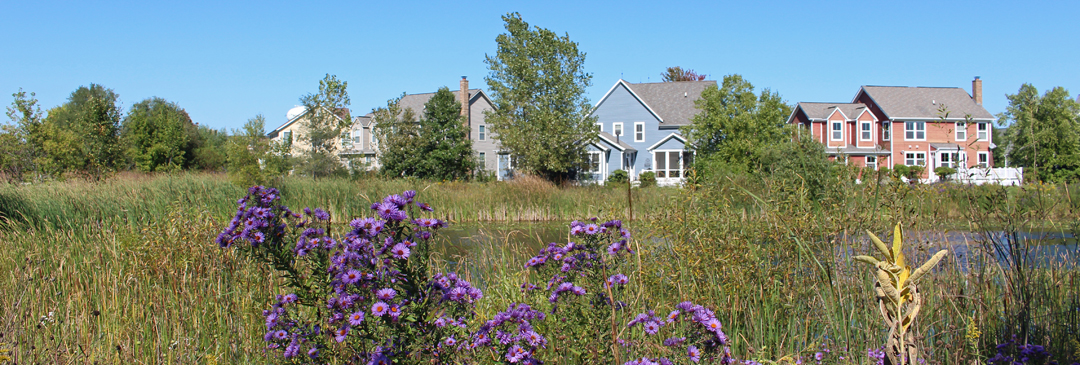A sense of place
Prairie Crossing is squarely rooted in its central Lake County location. Landscape and architecture are inspired by the prairies, marshes, and farms of the area. Street names in Prairie Crossing provide other reminders of the Midwest heritage of the community and are named after prairie plants and early settlers who frequented the site. The sense of place is further enhanced by the colors of the houses, with a palette of rich house colors derived from the earth tones and warm colors of the native landscape. The community buildings – an historic barn, a schoolhouse, and a farmhouse – remind us that others have lived on this land before, and that others, to whom we have responsibility, will live here after us. Click here for the next Guiding Principle, a sense of community.
Landscape
Prairie Crossing is well known for its beautiful native prairie landscaping. The land, which had been farmed for corn and soybeans prior to development, was replanted to the original native prairie and wetland plant species that covered the Midwest prior to nineteenth century cultivation.
Architecture
To reinforce the community’s sense of its Lake County roots, historic buildings were preserved for current use. One of these is the Byron Colby Barn, a dairy barn built nearby in 1885. It was taken down timber by timber and transported to Prairie Crossing, where a barn raising and renovation took place in 1996. The barn now serves as a community center and site for weddings, concerts, lectures, and other events.
Color Palette
The sense of place is further enhanced by the colors of the houses, which echo the earth tones and warm colors of the native prairie landscaping in the common areas and help create an inviting and cohesive community.
Street Names
Streets at Prairie Crossing provide other reminders of the Midwest heritage of the community. Many are named after the plants that once spread across Illinois such as Blazingstar, Coneflower, Goldenrod, Penstemon, Prairie Orchid, Prairie Smoke, Thimbleweed, and Wild Indigo. Many of those same native plants populate the restored prairies and wetlands in Prairie Crossing, strengthening the connection between the past and present.
Other streets are named for people relevant to the region’s history, including Amos Bennett and Colbee Benton. Born in Connecticut to freed slaves, Amos Bennett (1797-18??) was the first African American settler in Lake County and the first to run for public office here. Colbee Benton (1805-1880) was a merchant who traveled from Vermont to Chicago in the summer of 1883, and author of A Visitor to Chicago in Indian Days and Journal to the Far Off West.
Potawatomi Road in Prairie Crossing was named for the Potawatomi tribe, one of several American Indian tribes who called Lake County home. In 1833, the Potawatomi (along with the Chippewa and Ottawa tribes) signed over their last remaining Illinois lands (including Lake County) to the U.S. government in the Treaty of Chicago.
Resident Feedback
Feedback on the Guiding Principles is gathered annually in a survey. Here are several comments from residents related to this Guiding Principle:
- “The ESC (Environmental Stewardship Committee) strengthens our ‘sense of place’ greatly, by maintaining a unique prairie environment at Prairie Crossing.”
- “Living at Prairie Crossing connects my wife and I to both the land and the people who lived in central Lake County before us. We live in a place that celebrates that, instead of pretending to be some imaginary place with a name like Dartmoor Acres.”
 Prairie Crossing
Prairie Crossing